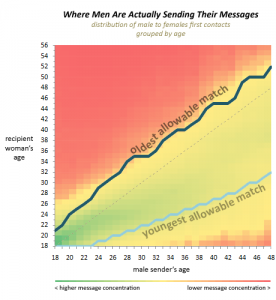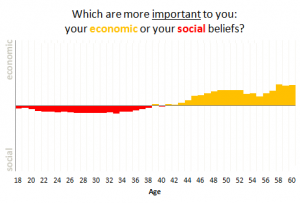Brian Baldeck took this picture during the Boston Marathon. Instead of just returning the boy’s high five, the soldier tore the United States flag from his uniform and handed it down, and then gave a high five.
The World
Making Too Much Lemonade
Katie Johnston writes in this morning’s Boston Globe on how Europe’s airport shutdowns in the wake of the Eyjafjallajökull volcano affect Boston:
Travelers’ despair aside, officials are considering the economic impact of the disruptions on Boston. Some are hoping that the loss of business from Marathon spectators who could not get here will be offset by those who can’t get out.
Summer
I’m not sure why, but this photograph from shallow_wing photography is terribly compelling:
I’m pretty sure this is what summer looks like.
OkTrends
I just stumbled onto OkTrends: the official blog of the free dating site OkCupid.
OkCupid asks members to answer questions that other members have written, and uses the answers to find good matches. Because anybody can write a question, the topics are not limited to smoking preferences and pet ownership, but cover the entire range of human activity. Have you been in prison? Would you prefer to go to a movie or a musical? How often do you shower? Do you like trying new foods? Should flag-burning be illegal?
The OkTrends blog studies this trove of data in the aggregate to derive some fascinating conclusions about dating in general and our society as a whole.
Consider The Case for An Older Woman. We see here, for example, what ages men prefer their partner to be.
Based on their “allowable match” settings, men are perpetually okay with women a little older, but are reluctant to give up on dating a young woman.
More importantly, the heat map shows whom men are actually contacting, with green areas indicating lots of messages. A 30 year-old man will say he’d only date someone 22 or older, but he “spends as much time messaging teenage girls as he does women his own age.”
Read the full article to see how women’s preferences compare.
OkTrends also translates data into practical advice for finding a match. For example, see Exactly What to Say in a First Message.
It’s heartening to see that messages with “netspeak” (like “ur” and “ya”) tend to elicit responses less than 10% of the time, compared to an overall average response rate of 32%. The word “sexy” also discourages replies, while non-physical compliments like “fascinating” encourages them. “Atheist” gets answers, but “God” does not. And discussion of specific interests (“vegetarian” or “zombie”) goes a long way.
Finally, the blog dissects some of the implications of its data for our society at large, in posts like The Democrats are Doomed, or How a “Big Tent” Can be Too Big.
I like in particular this depiction of social vs. economic beliefs. Perhaps we lose sight of our ideals as we get older?
Some of these broader conclusions suffer from the flaw that we can see only a snapshot in time. People who are 50 today grew up under different conditions than people who are 20 today, and may favor their economic beliefs (for example) for reasons other than their age. It’s fascinating either way.
Even though I’ll never need an online dating site again (nor any other form of dating, for that matter), I’ve still subscribed to this blog.
Coppélia
Boston Ballet’s Melissa Hough first caught my attention at this time last year when she danced the part of Princess Aurora in Sleeping Beauty. Tonight, I had the pleasure of seeing her in the title role of the ballet’s current production, Coppélia.
Her dancing was beautiful, elegant, and precise; her acting emotional and engaging; and her smile addictive. She made the show. And that’s saying an awful lot, given the talent and character of everyone on stage, in the orchestra, and behind the scenes of this performance.
Coppélia is the story of a girl, Swanhilde, who loves a boy who finds himself flirting from afar with someone else — someone who turns out to be just a life-sized doll atop the balcony of a toymaker’s workshop. Swanhilde (Hough) sneaks into the workshop, puts on the doll’s clothes, and simultaneously tricks the poor dollmaker into thinking his beloved creation has come to life while showing her beau how foolish he was to think the doll was a real girl.
The story is delightful and Boston Ballet tells it perfectly with beautiful sets and costumes, devine music, and most importantly, the best dancing this side of imagination. This was one of the best performances I’ve seen of any sort in quite some time.
Coppélia continues through April 18. I suggest you try it yourself.
Nanu Nanu: The Backyard Office
Design Milk published a pictorial a few days ago on offices built in people’s backyards titled The Rise of the Backyard Office. Evidently building a separate office in one’s backyard is a trend now. Many of those pictured are elegant and intriguing (and make me jealous), but I can’t can’t quite get past this one:
If I worked in that office, I’d feel compelled to come home every evening (across the yard, of course) with a joyful greeting of, “Nanu, Nanu!”
(Mork & Mindy? Anybody? Is “Nanu, Nanu” still a usable catchphrase? How about “Shazbot?”)
Pops Scores!
The Harvard Pops gave a delightful baseball-themed concert tonight, including Boston’s own baseball favorites like Shipping Up to Boston and Sweet Caroline. “Sporchestra” commentators narrated the event, providing (for example) play-by-play analysis of Beethoven’s 5th symphony:
The brass section has the theme… and now the basses have it… and now nobody has the theme! The audience can’t find the theme! Wait… what’s this… he’s introduced a new theme!
Mengruo Yang performed a mesmerizing and technically impressive solo on flute in Fantasie Brillante from Carmen (performed here, perhaps even more impressively, by 7 year-old “Emma“).
Megan Savage narrated the poem Casey at the Bat as Adam Lathram brought it to life. The Boston Pops had included this poem in their own baseball-themed concert last year, but I honestly liked conductor Allen Feinstein’s original music from tonight’s performance better.
My favorite line of the evening came when Adam Lathram was about to start a rigorous training routine for his upcoming bullfight in a montage set to the music of Rocky:
You’d better get a move on. You only have 163 measures.
All this begs the question: where were you while all this was going on?
Pixels
Patrick Jean made a video depicting what would happen to New York if it were attacked by 1980s video games:
I like the bit with Tetris best, but the entire thing is wonderful.
Children in a World of iPad
I was unimpressed with this the first time I watched it, but after trying it again I’m finding it entirely remarkable. Todd Lappin handed his new iPad to his 2.5 year-old daughter and filmed her first few minutes using the device.
This is cheating to some extent in that she’s already used an iPhone and therefore understood not only the basic interface but also many of the applications (including her games in particular).
That aside, however, the basic idea that children born today are faced with clear, intuitive interfaces for interacting with computers — and that they can learn to use a device like an iPad before even being able to read — is truly astounding.
YouTube has quite a few videos of children using an iPad (a surprising percentage of whom are 2.5 years old) which only emphasizes the basic point that we’ve invented a device young children can perhaps universally understand.
Moldy Highways
Clara Moskowitz at MSNBC reports on a study about traffic planning.
Researchers arranged oat flakes to mimic the layout of cities around Tokyo, and then set some slime mold loose. This mold grows as a large, interconnected network that tries to get the most efficient access to food — in this case, Japan-mimicking oat flakes.
The resulting network of mold ended up looking suspiciously similar to the train network that connects the real Tokyo to its real suburbs.
Apart from the quip Freakonomics makes about whether transportation engineers are as smart as mold, there’s also something to be said for the similarities between what we humans do to our environment and what mold does in its own.
(via Freakonomics)




